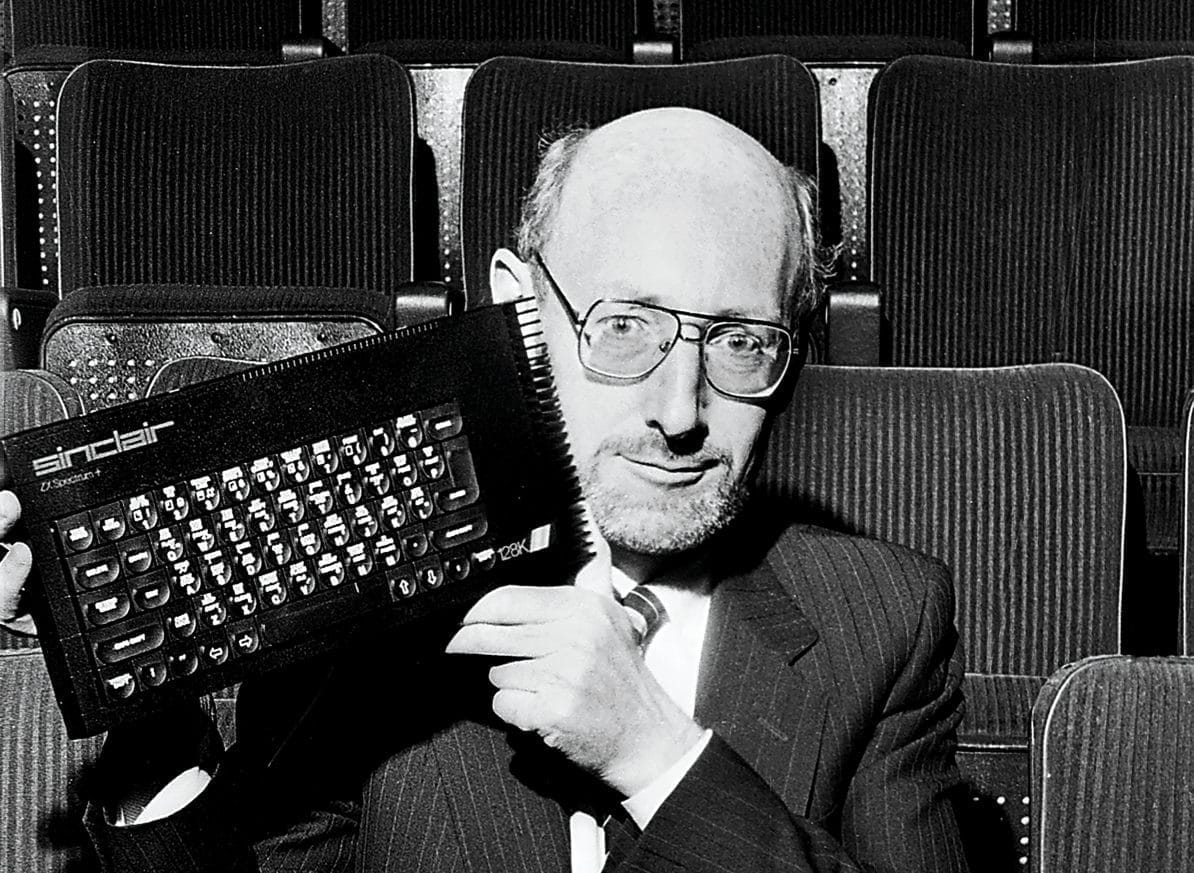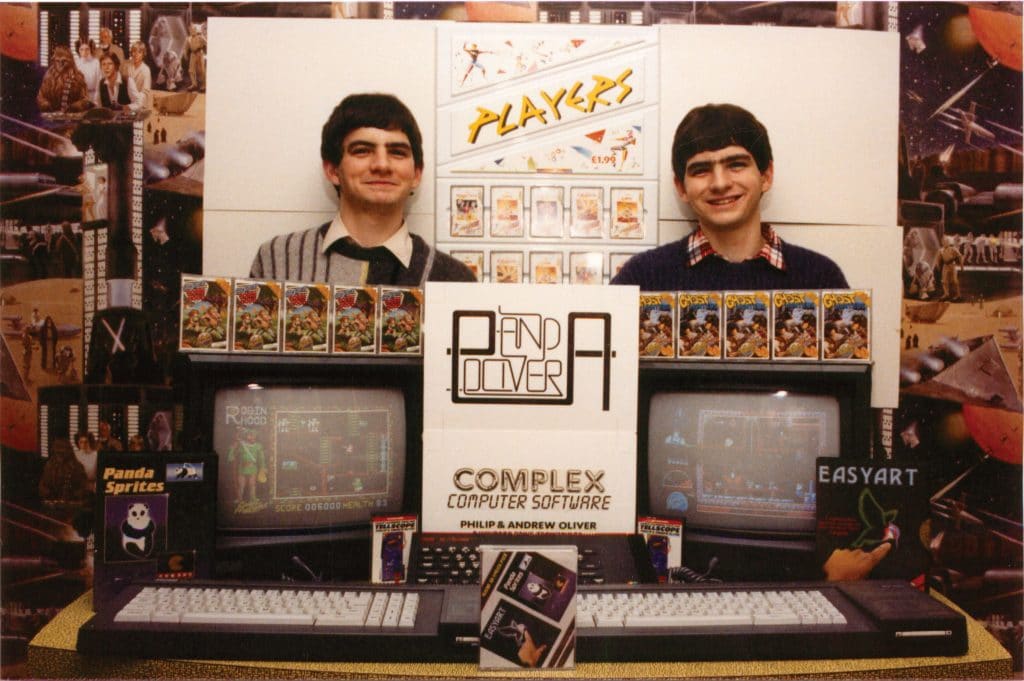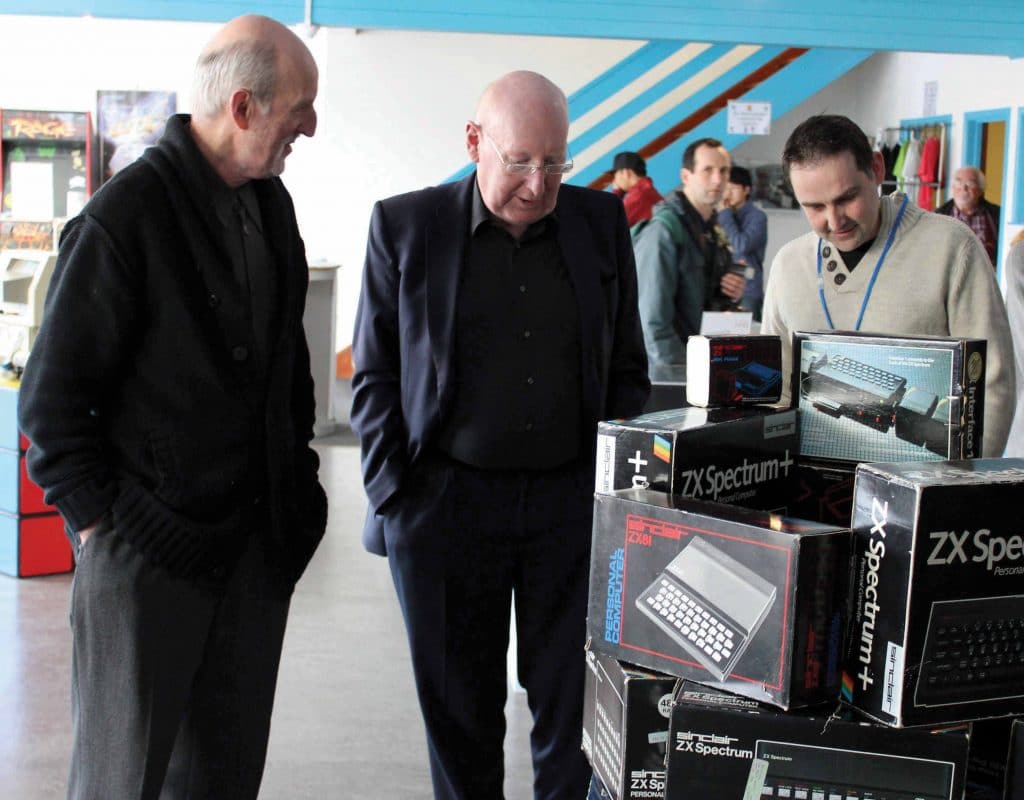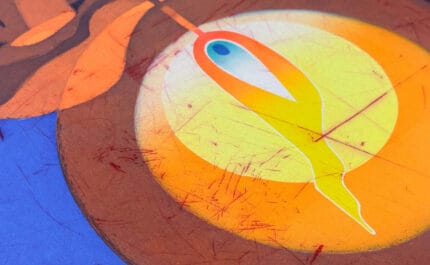The game changer
Sir Clive Sinclair, who died on 16th September, never intended for his most famous invention, the ZX Spectrum, to be used for gaming. Yet his pioneering home computer inspired young British coders to launch a video game revolution from their suburban bedrooms – and lay the foundations for an industry worth billions

Sir Clive Sinclair holding up a Sinclair ZX Spectrum 128 in 1986
16th September 2021 (Taken from: #44)
Philip Oliver still remembers the day in 1981 when his world changed. He and his twin brother, Andrew, were 13 when their older brother arrived at their home in Trowbridge, Wiltshire, with a brand-new Sinclair ZX81. “It was like he’d arrived with a portal into a different world,” remembers Philip, who was fascinated at the time by arcade games like Space Invaders. “We soon realised we could make it do things on a TV screen that at that point just had a few channels we could only watch. Our older brother was more into girls, and soon left it alone. But we were completely entranced.”
Thousands of kids in Britain had similar experiences in the 1980s, with the arrival of the ZX Spectrums, a range of dinky personal computers whose earlier models had rubber keys and tinny sound, and on which cassette games took several minutes to load. Their creator, Sir Clive Sinclair, who died on 16th September at the age of 81, was a serial electronics inventor who was on a mission to put a computer in every home. Whereas computers in the 1970s had often cost thousands of pounds, his ZX81, the popular precursor to the Spectrum machines, launched in March 1981 at just £69.95 – less than £300 in today’s money, and a steal compared to contemporary rivals like the American Apple II, which sold for $1,298. It was strikingly simple, using 8-bit technology that allowed only for blocky, pixellated graphics (the 1996 Nintendo 64 would use 64 bits, while the 2000 PlayStation 2 would use 128).
“In the 1970s, computers were the stuff of Bond villain lairs,” says Jason Fitzpatrick, the CEO of the Centre for Computing History museum in Cambridge, who was 11 when his parents bought him a ZX81. “They were scary to most people, and you had to go to intimidating specialist shops [to get them]. But Clive put computers in WH Smith, at a price that meant parents could buy them for their teenagers. The idea was that it would be a learning tool, but of course once it got in the hands of teenagers, they wanted games. Sinclair computers helped create a generation of British bedroom coders, who would form the basis of a whole industry.”
Cracking the code
Clive Sinclair wasn’t supposed to be the man who laid the foundations for the British video game industry. His real passion was making technology portable and affordable – starting with the Sinclair Executive pocket calculator in 1972, a slimline game-changer at a time when many calculators were still the size of shop tills. The mission of his first company, Sinclair Radionics, held firm even though some of his later inventions proved less successful, like the 1975 Black Watch, with a futuristic LED display, but a fundamental problem in that batteries ran out after ten days and were tricky to replace; or the MTV-1, a portable TV. For many, the most iconic image of the inventor comes from the snowy winter of 1985, when he proudly sat in his groundbreaking new Sinclair C5 electric tricycle, a 15mph machine that he hoped would usher in a new era of electric transport. It was a widely ridiculed flop, with the Sunday Times describing it on its launch as “a Formula One bath chair… [which] travelled five yards outdoors when everything went ‘phut’ and this motorised, plastic lozenge rolled to a halt with all the stationary decisiveness of a mule.”
If many of his inventions were ahead of their time, Sinclair picked the perfect moment for his ZX computer range, which arrived just as kids in Britain were getting hooked on arcade games like Pac-Man, Defender and Asteroids. The simple black ZX81, the follow-up to 1980’s ZX80, sold 1.5 million units. But its sales would be dwarfed by the smaller ZX Spectrum, which arrived in 1982 adorned with an iconic rainbow stripe. At a time when Apple computers were beige slabs, the ZX Spectrum was friendly and approachable, and would go on to sell more than five million units – far outstripping more expensive rivals like the Amstrad CPC, the BBC Micro and the Commodore 64 in the UK. It became a playground craze, creating enough of a market that teenage coders could, often to their own amazement, make money from selling their games.
I think Sinclair considered games to be fundamentally unserious”
Among these coders were the Oliver twins, who spent much of the early 1980s trying to impress their peers with the things they had created using the BASIC programming language, which relied on the painstaking entry of hundreds of lines of code. “We’d constantly be showing our sister or our mum or dad that we could make these blocks move around the screen, and they’d be wildly unimpressed,” remembers Philip, who graduated from coding on the ZX81 to a more powerful Dragon 32 home computer in 1982. “At school, we were the computer club kids, and we’d make these little games or art packages to show our friends. The feedback was mostly ‘That’s really rubbish.’”
But this stream of eminently humbling critiques helped them improve. In October 1983, they appeared on the BBC’s The Saturday Show for winning a game-design competition, demonstrating an abstract wall-building game to the nation while sporting matching bowl cuts and beige knitted jumpers. Many of their games in the first half of the ’80s didn’t scream smash hit, either – like Killapede, a static, low-budget Centipede-inspired game in which a spacecraft attempts to shoot a snake-like creature. Or Magic Maths for the Amstrad CPC, which demonstrated early computer speech with an oddly aggressive man demanding urgent answers to questions such as “What is three plus eight?”.

Philip and Andrew Oliver were writing a game a month for Sinclair Research’s ZX Spectrum in the 1980s
When they left school in 1986, the twins were desperate to keep going. Their dad, a naval engineer and nuclear-submarine designer, said they could have a year out to pursue their dream of making games, and could only continue if they made more money than him. “For the first time, we started to look at this like it might be a business,” says Philip. “So we went to WH Smith and started looking at what was selling. Often, games were successful just because they had a good cover or were linked to something in the cultural ether. We thought Ghostbusters was a rubbish game at the time, but people bought it because they liked the film.”
Seeking a recognisable story that wouldn’t require paying a licence fee, they settled on Robin Hood, adding the word ‘Super’ because superlatives played well (“Superman could never have just been Man, could he?”). With the concept for the Super Robin Hood platform game scrawled on a single sheet of A4, they took the idea to a computer show in London, where they met another pair of teenage brothers, Richard and David Darling. The Darling brothers had recently founded a budget games publisher called Codemasters, built on their earlier success with games like BMX Racers and Pigs in Space. Funded by their father, and with their sister Abigail working the front desk of their first office in Banbury, the brothers were already so successful that they were driving Toyota Celicas. “They said we could make £10,000 from the game, and we imagined ourselves getting a briefcase full of cash,” recalls Philip. “But when we actually read the contract, it said we’d get 10p for every copy sold.”
Still, the Darlings were right. The Oliver twins coded for 23 hours a day in shifts, releasing their puzzle-based platformer in time for Christmas. The game was a number one hit, and easily sold the 100,000 copies needed for the Olivers to reach their financial target.
According to Fitzpatrick at the Centre for Computing History, who met Sinclair, Sir Clive was “horrified” by the idea that games might become the Spectrum’s greatest legacy. The machine had initially been marketed to parents as an affordable machine for word processing and real-world problem-solving. “I think he considered games to be fundamentally unserious, and I think he had loftier ambitions for his creation,” says Fitzpatrick.
That partly explains why, in 1984, Sinclair ploughed the significant profits from the ZX Spectrum range into the higher-spec Sinclair QL, which was aimed at executives and business owners, and was both cheaper and more powerful than the IBM and Apple computers of the time. But the Sinclair QL was full of bugs on its rushed launch, and failed to sell. Within a year, Sinclair was struggling, as investors failed to materialise. By 1986, he was forced to sell most of Sinclair Research to Alan Sugar’s Amstrad for a modest £5 million, just a pound for every ZX Spectrum ever sold.
Let the games begin
Just as Sinclair himself was being driven out of computers, the British games industry was starting to kick into gear. Driven by early hits like space trading game Elite and joystick-masher Daley Thompson’s Decathlon, a very specific subculture built up around those magical cassette tapes during the mid-1980s. The developers may have been limited by blocky pixels, black backgrounds and bleepy sound, but in spite of this they broke through thanks to sheer creativity. Games often reflected the whimsy and weirdness of suburban teenagers, from the pixellated bullies and swots of Skool Daze to Trashman, about a traffic-dodging bin man. Then there was the trippy Deus Ex Machina, which at one point features British musician Ian Dury, best known for his 1977 hit ‘Hit Me with Your Rhythm Stick’ singing “I’m singing as I’m swimming” while the player has to guide a sperm across a sea of shimmering rivals. While the industry would later come to be defined by safe mega-hits and franchises, more than 2,000 unique games were published for the Spectrum alone, with titles including Fat Worm Blows a Sparky and My Name Is Uncle Groucho, You Win a Fat Cigar.
Unlikely stars were made of their creators, like Matthew Smith, a wild-haired 17-year-old from the Wirral, who in 1983 made Manic Miner, a platform game featuring a riot of spiders, poisonous pansies and Monty Python-esque giant boots, against a tinny but weirdly atmospheric version of Edvard Grieg’s ‘In the Hall of the Mountain King’. After his second hit, Jet Set Willy, Smith would disappear to live in a Dutch commune, with the internet still wondering about what happened to the ‘JD Salinger of gaming’ decades later.

A screenshot from Jetpac for the ZX Spectrum
By 1986, gaming – especially on the Spectrum – had become a playground craze to rival swapping football stickers. Your Sinclair magazine, launched that year, was a departure from its predecessor, the dry, technical Your Spectrum. It was a funny, anarchic read aimed at teenage boys which, like its rival Crash, also dedicated to the ZX Spectrum, took inspiration from Viz and Smash Hits. Teresa Maughan, aka T’Zer, who took over as editor in 1987, remembers becoming a curious sort of celebrity. “People would send me weird things, like strands of hair,” she recalls. “When we went to games shows, I’d get mobbed. There’d be teenage boys asking if I could sign their arms, just because they had nothing else I could sign.”
People would send me weird things, like strands of hair”
After Super Robin Hood, the Oliver twins were also on their way to an unlikely sort of fame. Their next games were hits, too: Grand Prix Simulator, a top-down racer endorsed by one-season F1 driver Johnny Dumfries (he finished 13th in the drivers’ championship), and Ghost Hunters, a platform game that borrowed from Ghostbusters, Scooby-Doo and the arcade game Operation Wolf. That allowed them to persuade the Darling brothers to publish their big idea: a game about a smiley somersaulting egg, with boxing gloves instead of arms, which Philip designed mainly because he wanted a character with a face big enough to smile with limited pixels. When they took Dizzy the anthropomorphic egg to the Darlings, the publishers were sceptical, given that Codemasters liked games to riff on popular sports or pop culture, which tended to mean that they would sell even if the reviews were bad.
But when Dizzy – The Ultimate Cartoon Adventure was released in 1987, it became a slow-burn sensation, and the Oliver twins began to become a brand in their own right. Subsequent games would come emblazoned with stickers saying “By the bestselling Oliver Twins!”, and at one point it was said that their creations were responsible for seven percent of all British game sales. More than 20 Dizzy games were eventually made, and Dizzy remains the most iconic video game character of all time in Russia, where the technical simplicity of the Spectrum and its games made it easy to clone behind the Iron Curtain.
While today’s big game-directors are cool – from Metal Gear Solid auteur Hideo Kojima to the Houser brothers behind the Grand Theft Auto series – back then they were nothing of the sort. “Saying you worked in computers was a good way to kill conversations,” says Philip. “There were very few grown-ups who understood what we did, or cared.” And while the Oliver twins started making serious money – as much as £200,000 a year in the late 1980s (around £590,000 in today’s money), which allowed 19-year-old Philip to buy a Honda Integra and a four-bedroom house – games businesses still had to be very much DIY affairs. “Bankers were even less impressed than prospective partners,” says Philip. “If you wanted a bank loan in those days, you’d have literally been better off saying you worked as a clown.”
Still, over time, the weird anarchic games born in the ’80s formed the basis of a UK games industry. Unlikely centres of creativity took root, like Leamington Spa, close to Southam, where Codemasters settled in 1986, and where the Oliver twins would start their own company, Blitz Games. Today, after employees from those enterprises spawned others, ‘Silicon Spa’ is home to 34 games companies, employing more than 900 people. Philip Oliver, whose company Panivox has just launched a voice-controlled games and entertainment platform called RichCast, says: “I remember in the really early days, we did an interview with a journalist at the Wiltshire Times, who said to us to make the most of it, because this was a passing fad. We were serious kids, and I remember saying to him: ‘No, this is the start of something really big, and one day these games will look like movies.’ It was obvious to us, even then, but people couldn’t understand it.”
Boom and bust
Sir Clive Sinclair, it’s fair to say, didn’t reap the benefits of the market he’d helped to create. Partly, it was down to a lack of interest. He famously didn’t use a computer or a calculator, and was always quick to move on to the next idea. Even his hobbies were eclectic: chair of Mensa throughout the ’80s, with an IQ of 159, his obsessions ran from poetry to poker and running marathons. After selling Spectrum to Amstrad, and the very public failure of his C5 electric scooter, the inventions kept coming – funded, increasingly, by Sinclair himself. He built the Zike electric bicycle in 1992, with limited commercial success, and tried and failed to get the bubble-like Sinclair X-1 electric vehicle to market. By 1997 – when he released the Sinclair XI radio, the size of a 10p coin – he was Sinclair Research’s sole employee.

Clive Sinclair (centre) and Jason Fitzpatrick of the Centre for Computing History (right)
In February 2021, by contrast, Codemasters was sold to American gaming giants Electronic Arts for $1.2 billion, having progressed from the Oliver twins’ blocky Grand Prix Simulator in 1987 to the hyper-realistic F1 games series (the Darling brothers got out early, having sold their shares in the business for around £80 million in 2007).
Codemasters isn’t the only British games giant to have been born in the ’80s era of the bedroom coders and gone on to huge success. Rockstar North, the creators of the Grand Theft Auto series, was born from DMA Design, a collective of bedroom coders in Dundee who started off making games for the Spectrum and its rivals. Another big 1980s developer and publisher, Ultimate Play the Game, was founded by Leicestershire teenage brothers Tim and Chris Stamper (“brothers could egg each other on and edit each other’s code,” says Philip Oliver). They graduated from early smashes Jetpac (1983) and Sabre Wulf (1984) to founding a game company called Rare, whose Nintendo 64 mega-hits in the 1990s included Donkey Kong 64 (1999) and GoldenEye 007 (1997), as the 8-bit computer age gave way to a new era of specialist games consoles.
In 2020, the UK video games industry was worth more than £7 billion, in a global industry worth $175 billion – more than the global music and film industries combined.
Sinclair’s computers inspired many people to start making games. “In many ways, he democratised the whole process of invention,” says Fitzpatrick. “Nowadays, if you have a great idea, there’s so much support, but what he did was hard. He brought Spectrum computers to market at a time when you didn’t have venture capitalists, and banks didn’t really have a clue what the product was. The Spectrum was hugely influential in making a creative space for people. It was a great facilitator.”
What if?
According to Philip Oliver, things would have been very different if Sinclair had started his business in the US. “There was more of a readiness to invest in potential over there, whereas here in the UK Clive was always cash-strapped,” he says. “If he had been in California, he would have given Apple a run for its money, and maybe even won.”
He could be irascible, but also loyal, kind and shy, with a much softer side than Jobs had”
The comparisons with Apple’s Steve Jobs are interesting, too. While Jobs was retrospectively turned into a cultish corporate messiah, Sinclair’s main depiction in British culture was a slightly needling portrayal by Alexander Armstrong in 2009 BBC drama Micro Men. Many of the obituaries of Sinclair were accompanied by images of him on his failed C5 electric cycle, characterising him as a lovable eccentric rather than a game-changing disruptor, whose ideas for digital watches and electric vehicles would eventually become part of the mainstream. According to Fitzpatrick, “He could be irascible, but also loyal, kind and shy, with a much softer side than Jobs had.”
Teresa Maughan remembers the time when Your Spectrum had a party on a boat in London in the second half of the 1980s, and secured Sinclair as a star guest. “There was so much anticipation, because he was a hero to so many people,” she recalls. “But I remember seeing this lonely figure walk up the quayside, and I could sense him looking at this boat full of drunken journalists. He just turned around, and walked the other way into the darkness.”
Sinclair was a catalyst whose work helped others: not just game developers, but the disruptors of the future, including Elon Musk, who tweeted after his death “RIP, Sir Sinclair. I loved that computer.” For Musk, like so many people who would go on to change things, the ZX Spectrum, with its curious bleeps and tantric loading process, was a sign that anything might be possible.
Slow Journalism in your inbox, plus infographics, offers and more: sign up for the free DG newsletter. Sign me up
Thanks for signing up.








